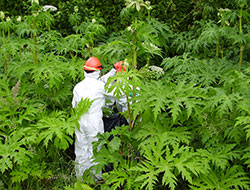Giant Hogweed
Heracleum mantegazzianum • Class A |
||
| Family Name: | Apiaceae family (ay-pee-AY-see-ee) | |
| Common: | Carrot/celery family (formerly Umbelliferae) | |
| Genus: |
Heracleum (Hair-uh-KLEE-um) Meaning: Named for Hercules, who was supposed to have used it first for medicine |
|
| Species: |
mantegazzianum (man-tee-gaz-zee-AH-num) Meaning: Named Paolo Mantegazzi, 19th century Italian etnographist (sociologist/anthropologist) |
|
| Description: |
The Giant Hogweed closely resembles the cow parsnip, except for its huge size, reaching heights of up to 15 feet tall. The hollow, sturdy stalks are covered in dark reddish, purple splotches. The hollow sturdy stems are covered in coarse white hairs and dark purple/red splotches. Stiff, bristly hairs also surround the base of the leaf stalk. The leaf stalks are also purplish. It's deeply cut, compound leaves are up to 5 feet in breadth. Its white umbrella-shaped flower clusters are up to 2.5 feet in diameter. The seeds are winged and spread through wind and water. Seeds remain viable in the ground for approximately 7 years. |
| Why Is it a Noxious Weed? |
Giant Hogweed is a public health hazard. Its clear watery sap contains toxic chemicals which make the skin highly sensitive to the sun and other sources of ultraviolet light. Skin contact with this sap followed by sun exposure produces painful, burning blisters. Temporary, or even permanent blindness can result if the sap enters the eye. It is also very invasive and forms dense canopies which choke out native vegetation and increase soil erosion.
|
| Where Does it Grow? |
It prefers rich, damp soil and grows along roadsides, ditches, vacant lots, streams and rivers, and vacant farmland. Seventy percent of all Giant Hogweed sites are found in urban areas. It is less effective than native plants at binding soil, so infestations lead to increased soil erosion. |
| Facts: |
Most Giant Hogweed plants are monocarpic perennials, dying after they flower and produce seed. Though it may take from four to fifteen years from the time a seed germinates until the plant produces a flowering stem. |
| Control Options: |
|
| More Information: |
Download our Flyer or visit Washington State Noxious Weed Control Board Here. Photo by Rebecca Shoemaker, Pierce County Noxious Weed Control Board.
|
| More Pictures: |







 Pierce County Noxious Weed Control Board • 9200 122nd St E, Puyallup, WA 98373 • 253-798-7263
Pierce County Noxious Weed Control Board • 9200 122nd St E, Puyallup, WA 98373 • 253-798-7263